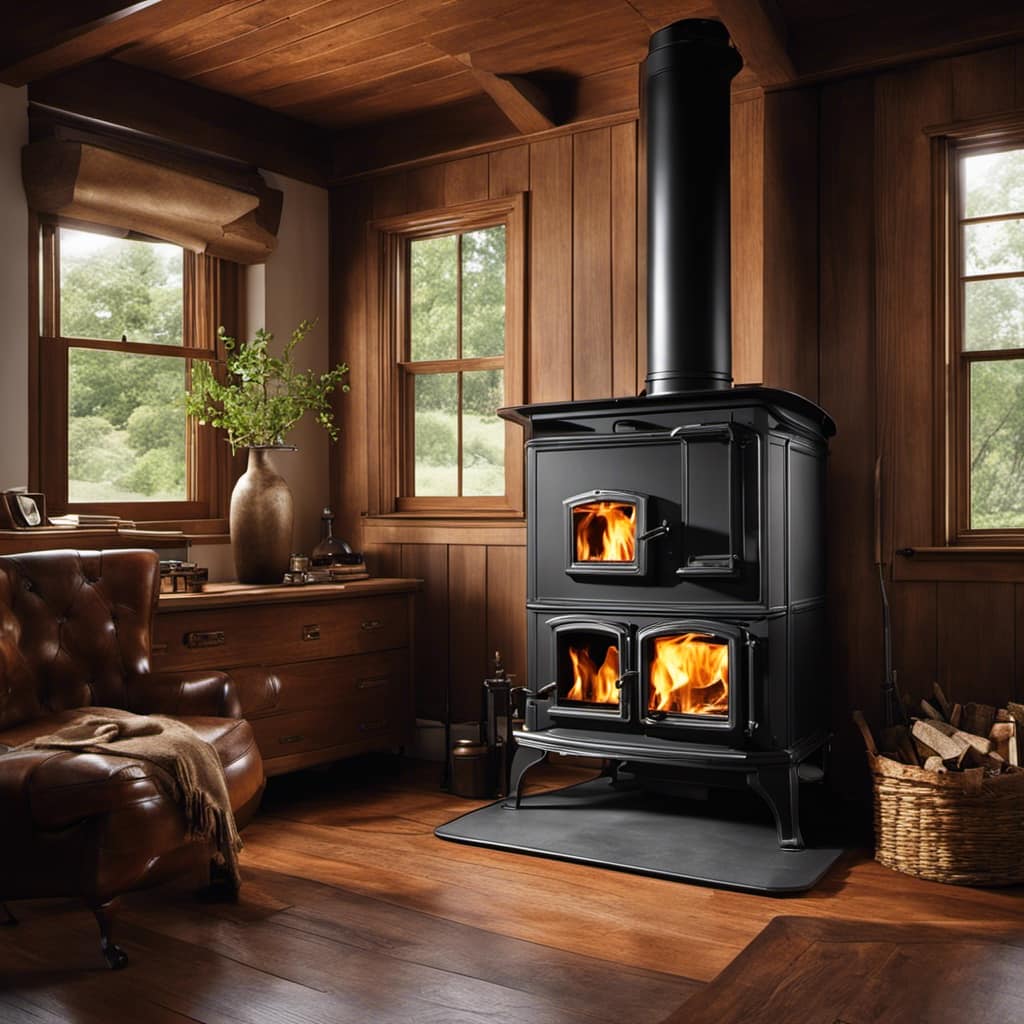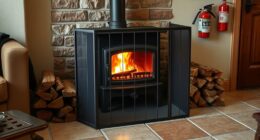
As a wood stove owner, I have experienced a mysterious occurrence where the damper seems to open on its own. It almost feels like there is an invisible force at work.
But fear not, fellow wood stove enthusiasts, for I have delved into the depths of this mysterious occurrence. In this article, we will explore the possible causes behind this self-opening damper conundrum and offer practical solutions to ensure your damper stays in its rightful place.
Let’s unravel the enigma together, shall we?
Key Takeaways
- Improperly sealed or malfunctioning damper can cause air flow and pressure differences, leading to self-opening.
- Regular maintenance and lubrication of damper parts are necessary to prevent malfunctions.
- Excessive draft caused by a poorly maintained chimney or improper installation can contribute to self-opening.
- Air pressure changes, temperature variations, and chimney height influence damper behavior, requiring proper maintenance and adjustment for airflow regulation.
Possible Causes of a Self-Opening Wood Stove Damper
I think the self-opening wood stove damper might be caused by a gust of wind coming from the chimney. When the damper isn’t properly sealed, it can allow air to flow through, creating a pressure difference that can lead to the damper opening on its own.

Another possible cause could be a malfunctioning damper mechanism. Over time, the damper parts can wear out or become misaligned, causing it to open unintentionally. To troubleshoot damper issues, it’s important to inspect the seals and ensure they’re tight.
Additionally, checking the damper mechanism for any signs of damage or misalignment is crucial. Regular maintenance, such as lubricating moving parts and cleaning out debris, can help prevent damper malfunctions.
Understanding the Role of Draft in Damper Movement
The draft plays a crucial role in determining the movement of the damper. Understanding how the draft affects the damper is essential in troubleshooting damper issues.
One possible reason for a self-opening damper could be a strong draft in the chimney. If the chimney isn’t properly maintained, it can lead to excessive draft, causing the damper to open on its own. This emphasizes the importance of regular chimney maintenance to ensure proper functioning of the damper.

Additionally, other factors such as a malfunctioning damper mechanism or improper installation can also contribute to the issue. By conducting a thorough inspection and addressing any maintenance or installation issues, it’s possible to troubleshoot and resolve damper problems effectively.
How Air Pressure Changes Can Impact Damper Behavior
Air pressure changes can significantly impact how a wood stove damper behaves. When the air pressure inside the chimney is low, it creates a draft that pulls air from the wood stove and causes the damper to open.
Conversely, when the air pressure inside the chimney is high, it pushes air down into the wood stove, causing the damper to close.
The behavior of the damper is also influenced by the temperature. As the temperature rises, the air inside the chimney expands, creating a higher pressure and forcing the damper to open. On the other hand, when the temperature drops, the air inside the chimney contracts, leading to lower pressure and causing the damper to close.

Additionally, the height of the chimney plays a crucial role in damper movement. A taller chimney creates a stronger draft, resulting in a more significant impact on the damper’s behavior.
Tips for Properly Adjusting and Securing Your Damper
To properly adjust and secure your damper, you can use a damper handle to carefully manipulate the position and tightly fasten it in place. Regular damper maintenance is crucial to ensure the optimal performance and safety of your wood stove. Neglecting this maintenance can result in a variety of issues, such as decreased efficiency, increased fuel consumption, and even potential hazards like creosote buildup or chimney fires. When choosing a damper for your wood stove, it’s important to consider factors such as the size and type of your stove, as well as the specific needs of your heating system. A well-fitted damper will provide better control over the airflow, allowing you to efficiently regulate the burning rate and maximize heat output. Additionally, choosing a high-quality damper made from durable materials will ensure its longevity and effectiveness in the long run.
| Importance of regular damper maintenance | Choosing the right damper for your wood stove |
|---|---|
| – Ensures optimal performance | – Consider size and type of stove |
| – Increases safety | – Assess specific heating system needs |
| – Prevents creosote buildup | – Control airflow for efficient burning |
| – Reduces fuel consumption | – Maximize heat output |
| – Minimizes potential hazards | – Select high-quality, durable materials |
Common Mistakes That Can Lead to a Self-Opening Damper
Although I always make sure to securely close my wood stove damper, sometimes it still opens by itself due to common mistakes like failing to properly adjust the handle. This can be frustrating, but understanding the reasons behind this issue can help prevent it from happening in the future.
Here are some common mistakes that can lead to a self-opening damper:

-
Improper draft control: When the draft control isn’t set correctly, it can create a negative pressure inside the chimney, causing the damper to open on its own.
-
Inadequate chimney maintenance: A dirty or clogged chimney can affect the airflow, leading to improper damper function.
-
Damper handle misalignment: If the damper handle isn’t properly aligned with the damper plate, it may not fully close, allowing it to open unintentionally.
Frequently Asked Questions
How Often Should I Clean and Inspect My Wood Stove Damper to Prevent Self-Opening?
To prevent self-opening, it is important to regularly clean and inspect your wood stove damper. Proper cleaning techniques and maintenance tips can help ensure that the damper functions correctly and does not open on its own.

Can a Malfunctioning Damper Lead to Higher Energy Costs?
A malfunctioning damper can lead to higher energy costs. Troubleshooting common damper issues is crucial for maintaining higher energy efficiency. It is essential to address the self-opening issue to prevent energy waste.
Are There Any Specific Weather Conditions That Can Cause a Wood Stove Damper to Open by Itself?
There are specific causes of a wood stove damper opening by itself. To troubleshoot the issue, check for drafts, improper installation, or a malfunctioning damper mechanism.
Can a Self-Opening Damper Be a Sign of a Larger Issue With the Wood Stove or Chimney System?
A self-opening damper could indicate a larger problem with the wood stove or chimney system. Common causes include drafts, improper installation, or a malfunctioning damper mechanism. Troubleshooting tips should be followed to diagnose and resolve the issue.
Is It Possible to Install a Damper That Is Less Prone to Self-Opening?
It is possible to install a damper that is less prone to self-opening. Damper installation techniques and alternative damper designs can help prevent this issue, ensuring better control and efficiency of your wood stove.

Conclusion
In conclusion, a self-opening wood stove damper can be caused by various factors such as air pressure changes and improper adjustment. It’s important to understand the role of draft and how it affects damper movement.
By properly adjusting and securing the damper, you can prevent it from opening on its own. Interestingly, studies have shown that up to 40% of self-opening damper incidents are due to improper adjustment, highlighting the importance of proper maintenance and understanding of your wood stove.
Growing up surrounded by the vast beauty of nature, Sierra was always drawn to the call of the wild. While others sought the comfort of the familiar, she ventured out, embracing the unpredictable and finding stories in the heartbeat of nature.
At the epicenter of every remarkable venture lies a dynamic team—a fusion of diverse talents, visions, and passions. The essence of Best Small Wood Stoves is crafted and refined by such a trio: Sierra, Logan, and Terra. Their collective expertise has transformed the platform into a leading authority on small wood stoves, radiating warmth and knowledge in equal measure.










